Photobiomodulation Therapy (PBMT) is a type of light therapy that uses lasers or LEDs. It’s also called low-level laser therapy (LLLT). We'll be using the terms PBMT, low-level laser therapy, and laser therapy interchangeably. In this article, we'll go through the different uses for this type of laser therapy.
The "low-level" aspect of this therapy refers to the fact that the photons that the laser emits are at a non-thermal irradiance. Photons are the basic units of light. This type of laser therapy is non-invasive and very safe. Laser therapy is used to reduce pain and inflammation, to restore certain impaired functions, to modulate the immune system, and to improve tissue repair.
Low-level laser therapy was first discovered in the 1960s. During that time, laser medical technology was still quite expensive and carried safety concerns. But when LEDs were introduced to laser therapy, safety concerns and expenses went down. Plus, the devices became much easier to operate. And although we advise only using a trained professional for this therapy, there are now LED-based photobiomodulation devices sold for home use.
Low-level laser therapy’s effectiveness in regenerative medicine has led to its use by the US and British militaries, sports teams and sports therapists, and pain clinics all over the world.
Low-level laser therapy’s safety and ease of use are partly why it has gained popularity over the years. In fact, interest in it has prompted hundreds of randomized clinical trials to be published on it so far.
More recently, there have been a number of interesting reviews that helped get laser therapy more into the mainstream. Most of these studies were conducted on patients suffering from symptoms such as pain, stiffness, and inflammation that resulted from different conditions.
They include findings on low-level laser therapy’s effectiveness for the following issues:
For more info on these studies, we've summarized many of them later in this article and included links to the originals.
Laser therapy seems to benefit the skin the most. You can use laser therapy for many dermatological concerns, such as skin burns, wrinkles, acne scars, and the reduction of UV damage. You can also use it for vitiligo, psoriasis, and acne. The best part is that it has relatively no side-effects, unlike some of the medications used to treat these issues.
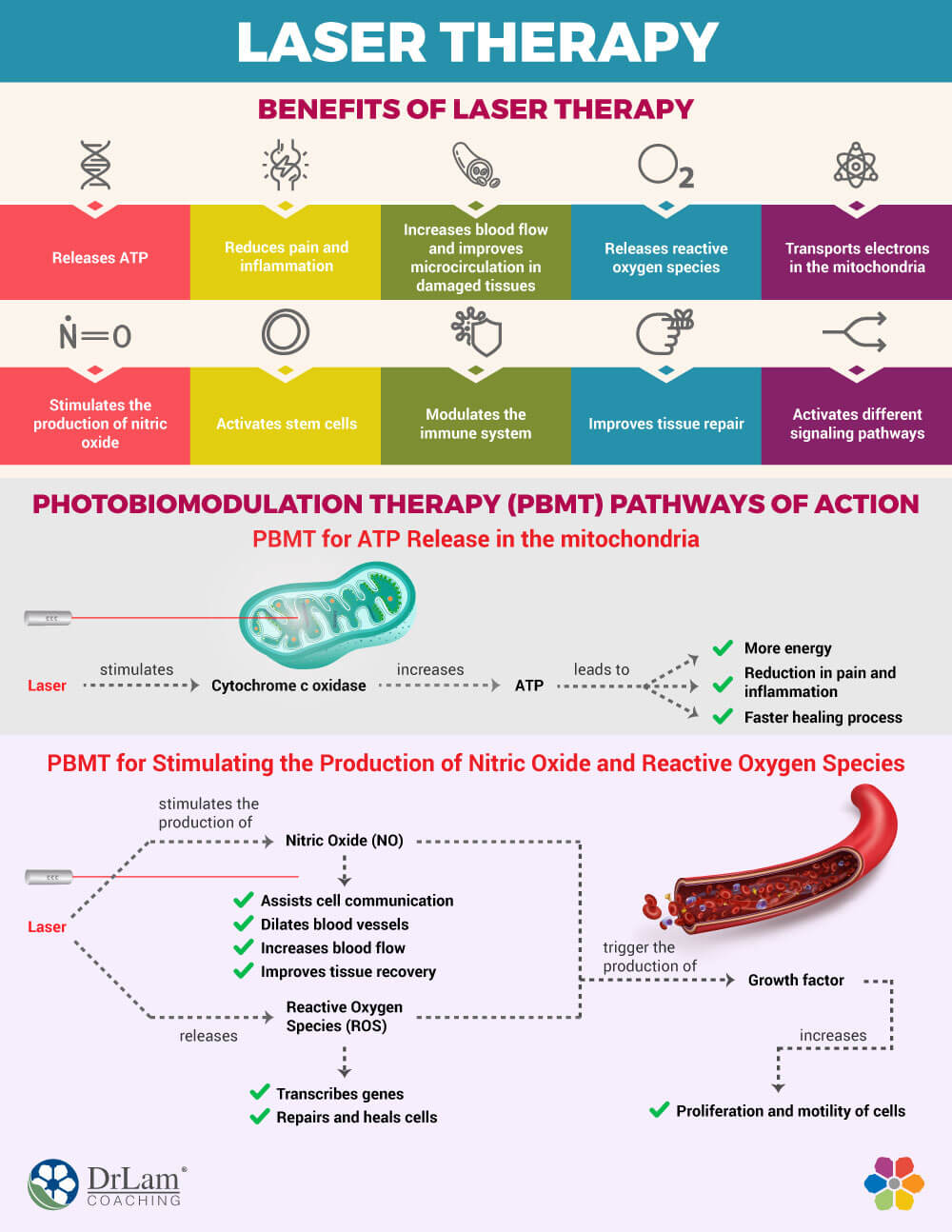
In photobiology, the effects of different wavelengths of radiation on biological systems are studied. In fact, the reaction of biological systems to light has been an area of study for a long time.
For example, the synthesis of vitamin D by our skin in response to sun exposure is a photochemical reaction that is very well-known. Another example is the chemical reaction in our retinas that occurs when light hits them. This is how we see.
Understanding the ability of light to affect biological systems is what has led to light being used deliberately to create certain desired photochemical reactions.
There is scientific consensus that applying a specific dose of light to damaged or dysfunctional tissues can be therapeutic. It seems to trigger the following pathways, which are covered in more detail below:
PBMT utilizes non-ionizing light. This means that it doesn’t carry enough photon energy to remove an electron from an atom or molecule. PBMT can emit light in different ranges of the electromagnetic spectrum. The key is that the light has to be administered at a therapeutic intensity and dose.
The intensity of the photons has to be adequate on one hand and not too high on the other. If it’s inadequate, it will not be absorbed, and if it’s not absorbed, it will not give the desired outcome. If it’s too high, the photon energy will turn into excess heat in the tissue being targeted, which is also something to avoid.
The dose, also called "fluence," has to be enough as well. If it’s too low, the body will not achieve the desired result.
Laser therapy emits light that can be absorbed by the mitochondria inside the cells. Mitochondria are the factories that create ATP, the energy currency of life. When the laser triggers these mitochondrial mechanisms, they lead to a reduction in pain and inflammation, and they also speed up the healing process.
Inside the mitochondria, there are chromophores, one of which is what laser therapy targets. This is the enzyme cytochrome c oxidase, and it is an important part of the electron transport chain that propels cellular metabolism. As the light comes into the cells, it stimulates cytochrome c oxidase, which then increases the production of ATP.
More ATP means more energy, and that means your physiological processes, including healing and repair, have more energy to conduct their work.
Laser therapy also stimulates the production of nitric oxide (NO). NO is a molecule that helps the 50 trillion cells of your body communicate with each other. It does that by acting as a signal transmitter. It also helps with vasodilation, meaning it dilates blood vessels, thereby increasing blood flow. This is especially good for improving microcirculation in tissues that have been damaged. This enhanced circulation delivers more oxygen, proteins, salts, and sugars to the tissues that need repair.
Laser therapy also releases mild oxidants, or reactive oxygen species (ROS), which are another signaling molecule. This leads to the transcription of genes, and then to the repair and healing of cells. Together, NO and ROS trigger the production of growth factor. Growth factor increases the proliferation and motility of cells.
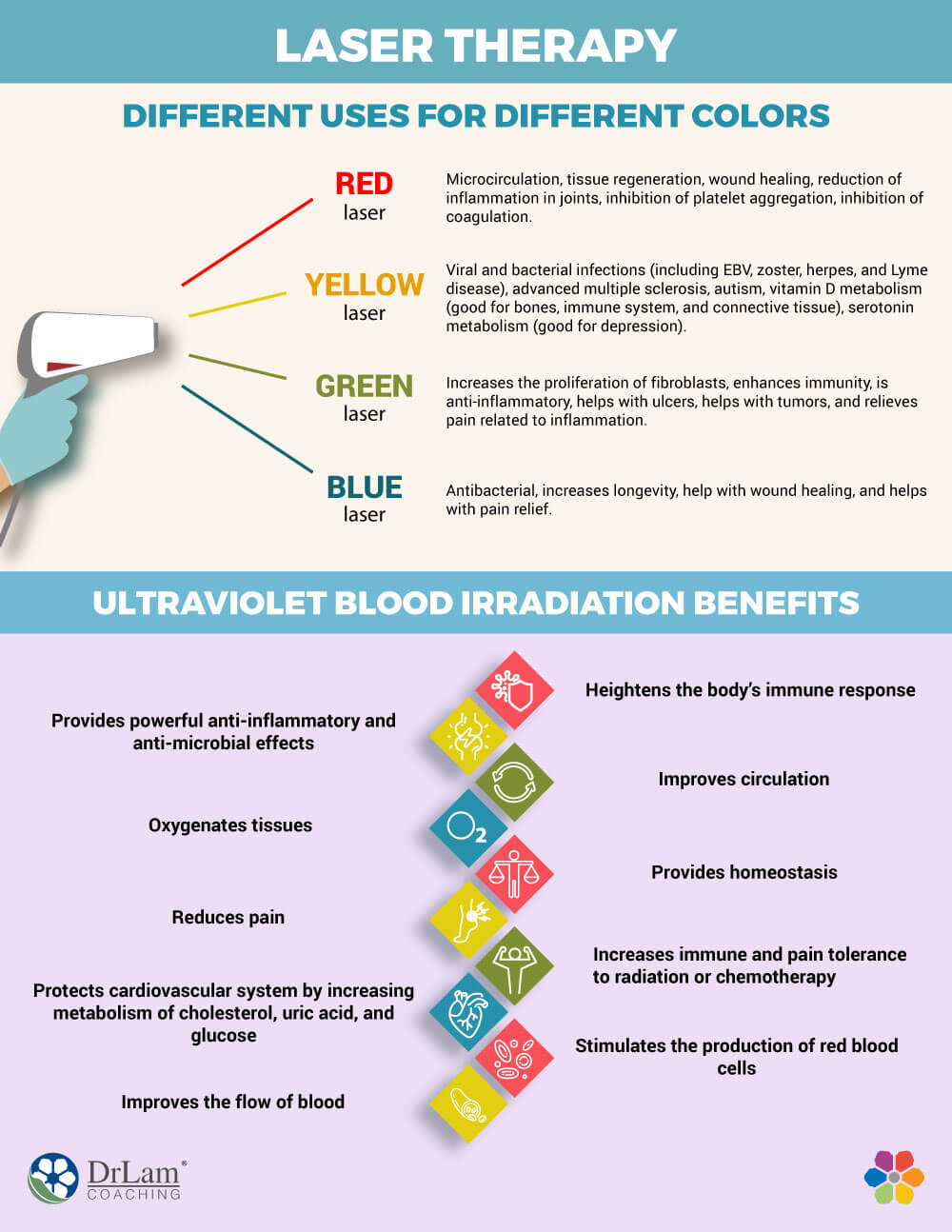
There are four main color categories low-level laser therapy falls under: yellow, red and infrared, blue, and green. Each one has its own wavelength range, absorbability, physiological effects, and clinical applications. Below is a summary of each.
As this list shows, laser therapy can be useful for a wide variety of conditions and symptoms. But that doesn’t mean that you should use it without first taking a few things into account.
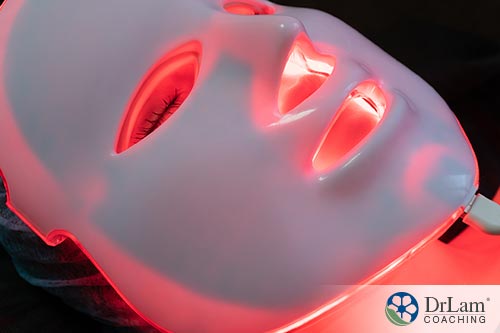 There is a variety of ways to deliver LLLT to your body, from transdermal to intravenous delivery via fiber optics. Even though low-level laser therapy is safe when properly used, it is still important to use a lot of caution when considering it.
There is a variety of ways to deliver LLLT to your body, from transdermal to intravenous delivery via fiber optics. Even though low-level laser therapy is safe when properly used, it is still important to use a lot of caution when considering it.
This is because, first, clinical uses are in early phases of clinical development. Secondly, we don’t know if it could be detrimental if you have a pre-existing condition that weakens your body's ability to handle stress, like adrenal fatigue.
Adrenal Fatigue Syndrome (AFS) is a condition you can get if you have chronic stress. Its symptoms include fatigue, weight gain, insomnia, brain fog, anxiety, mild depression, hypoglycemia, salt and sugar cravings, low libido, PMS, infertility, hair loss, dry skin, estrogen dominance, lightheadedness, heart palpitations, lowered immunity, food and drug sensitivities, and an inability to handle stress.
The different types of stressors that can trigger AFS fall into two categories: physiological and psychological. Physiological stressors include:
Psychological stressors could be caused by anything from work pressure to mental health issues, financial stress, and relationship problems.
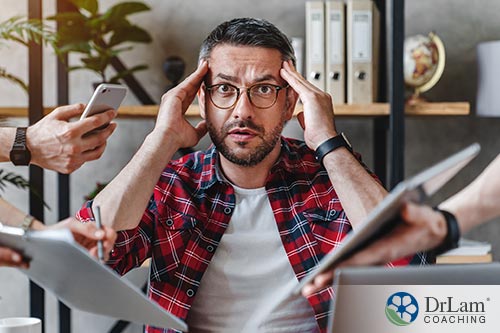 These stressors activate your hypothalamic-pituitary-adrenal (HPA) axis. The HPA is a type of hormone cascade that begins with the control center in the brain: the hypothalamus and pituitary gland. When your hypothalamus receives information from your body that there is stress, it releases corticotropin-releasing hormone (CRH). CRH makes the pituitary gland secrete adrenocorticotropic hormone (ACTH). ACTH then goes to the adrenal glands and stimulates them to release cortisol.
These stressors activate your hypothalamic-pituitary-adrenal (HPA) axis. The HPA is a type of hormone cascade that begins with the control center in the brain: the hypothalamus and pituitary gland. When your hypothalamus receives information from your body that there is stress, it releases corticotropin-releasing hormone (CRH). CRH makes the pituitary gland secrete adrenocorticotropic hormone (ACTH). ACTH then goes to the adrenal glands and stimulates them to release cortisol.
Cortisol is your body’s main anti-stress hormone, and it has many different roles. Some of its functions include regulating blood pressure and blood sugar levels, maintaining heart and blood vessel function, suppressing the immune system, and neutralizing inflammation.
In the beginning stages of AFS, cortisol levels keep rising so your body can deal with all the stress. But after a while, your adrenals become exhausted and their cortisol output drops. That marks the more advanced stages of AFS.
If you’re in the earlier stages of AFS, laser therapy might be useful. It could help with the inflammation that is almost always present when you have chronic stress. It can help with mild symptom relief, especially for the pain that accompanies inflammation. And it is gentle enough not to trigger your adrenals to work even harder.
And, that’s the key question with any therapy if you have AFS: will it add to the stress and put pressure on your adrenals to work harder?
With that in mind, we don’t recommend laser therapy for those with more advanced stages of AFS, such as adrenal exhaustion and adrenal failure. But there’s more to it than just the adrenals.
Stress engages your entire body, not just your adrenal glands. That’s because your adrenals are only one component of the Hormone circuit of the NeuroEndoMetabolic (NEM) Stress Response. Your NEM is your body’s global response to stress, and it’s composed of six circuits: the Hormone, the Bioenergetics, the Cardionomic, the Neuroaffect, the Inflammation, and the Detoxification circuits.
Although your NEM is capable of handling acute bouts of stress, if your stress is chronic, it will dysregulate your NEM. And depending on which circuit is most effected, your symptoms will vary.
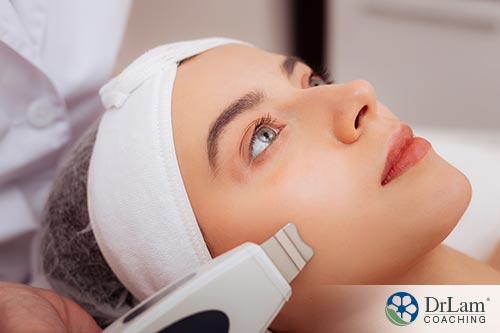 This is why AFS is often confused with other conditions. It’s also why you need to be careful with any form of therapy when you have AFS or NEM dysregulation. A therapy might focus on addressing one issue, such as acne, but end up adding stress to a related circuit, which can then impact your entire NEM.
This is why AFS is often confused with other conditions. It’s also why you need to be careful with any form of therapy when you have AFS or NEM dysregulation. A therapy might focus on addressing one issue, such as acne, but end up adding stress to a related circuit, which can then impact your entire NEM.
Laser therapy can affect each of the NEM circuits somewhat differently. Thus, it helps to know the basics of each circuit, how laser therapy affects it, and which color laser is most beneficial.
Your NEM’s Hormone circuit is composed of your adrenals, thyroid, and gonads (testes or ovaries). Each one of these components is the last link of a hormone cascade that begins with the control center in the brain - the hypothalamus and the pituitary gland. We already mentioned the HPA. But there’s also the hypothalamic-pituitary-thyroid (HPT) axis and the hypothalamic-pituitary-gonadal (HPG) axis. In women, there is also the ovarian-adrenal-thyroid (OAT) axis.
Each axis is intimately linked with the others, and each component will manifest different symptoms when it is the one most affected. For example, if your adrenals are most affected, your main symptoms will be anxiety, irritability, and fatigue. When it’s your thyroid, you will see weight gain, low energy, mild depression, and PMS as more prominent symptoms. If it’s the ovaries, your main symptoms will be brain fog, memory loss, PMS, and estrogen dominance. Also, with hormonal imbalances, skin symptoms are quite common.
From what we know about laser therapy, blue lasers may be the most useful, as they have a hormone-harmonizing effect.
Your NEM’s Bioenergetics circuit is responsible for your body’s metabolism. It’s composed of the thyroid, pancreas, and liver. The thyroid is what's responsible for your basal metabolic rate; the pancreas secretes enzymes and hormones that help metabolize glucose; and the liver is what helps clear toxins out.
In essence, because all the color types of laser therapy act on ATP production, they all could help with your Bioenergetics circuit. They can stimulate the mitochondria to produce more ATP, which can then be used by your body for different physical functions.
Another NEM circuit that laser therapy can help is your Cardionomic circuit. It’s composed of your cardiovascular system, your adrenal glands, and your autonomic nervous system. It’s responsible for readying the heart and blood vessels to pump oxygenated blood all over your body during a “fight or flight” response.
Because laser therapy increases the release of NO, which dilates your blood vessels, it can help your Cardionomic circuit perform better. It can also help repair the different blood vessels that may have incurred damage due to an overactive Cardionomic circuit. Red, infrared, and green lasers seem to especially helpful for the blood and cardiovascular system.
Your NEM’s Neuroaffect circuit is composed of your brain, autonomic nervous system, and microbiome. The microbiome is the ecosystem of flora in your gut.
Your body’s stress response is initiated in your brain. Its main drivers are the hypothalamus and pituitary gland, as we saw with the HPA axis. The Neuroaffect circuit’s job is to release neurotransmitters that either put your body on alert when stress is present or calm it down once the stress is gone.
When it dysregulates, this circuit can create different psychological and neurological symptoms. These can include issues such as anxiety, panic attacks, and insomnia. If norepinephrine is one of the neurotransmitters it releases, it could make your heart pound.
Interestingly, near-infrared light can help stimulate the mitochondria in neurons. It does that by donating photons that then get absorbed by the cytochrome c oxidase enzyme. This is called "photoneuromodulation." Cytochrome c oxidase in the brain gets activated and leads nerve cells, including those in the brain, to consume more oxygen. This means more ATP is produced in the brain as well.
The energy from laser therapy can actually get to the brain’s mitochondria through the skull. It can therefore directly stimulate the cytochrome c oxidase activity there. Yellow lasers can also help with serotonin production, which is your “happiness” neurotransmitter. This can aid with depression.
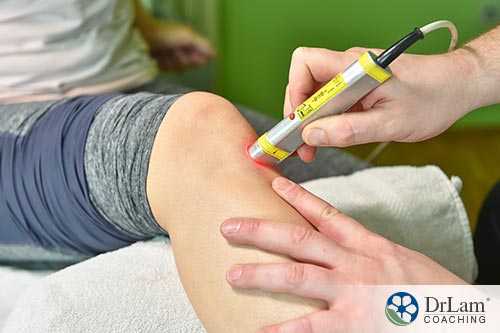 Your NEM’s Inflammation circuit is composed of your immune system, your gastrointestinal (GI) tract, and your microbiome. Because the microbiome is involved in this circuit as well as in the Neuroaffect circuit, and because most of your neurotransmitters are made in your GI tract, inflammation in your gut can create psychological and neurological symptoms. In fact, chronic low-grade inflammation is now being accepted as one of the main factors in depression.
Your NEM’s Inflammation circuit is composed of your immune system, your gastrointestinal (GI) tract, and your microbiome. Because the microbiome is involved in this circuit as well as in the Neuroaffect circuit, and because most of your neurotransmitters are made in your GI tract, inflammation in your gut can create psychological and neurological symptoms. In fact, chronic low-grade inflammation is now being accepted as one of the main factors in depression.
Inflammation, when it’s an acute response to harmful stimuli, is a necessary and healthy part of your immunity. The problem arises when it becomes chronic. It can then spread to many different areas of your body and create a lot of damage there. If the harmful stimuli are pathogens, yellow and blue lasers can help because they have strong antiviral and antibacterial effects.
Because red and infrared laser therapy is quite effective in reducing inflammation, it can really benefit your Inflammation circuit as well. It can also help to repair the damage already done by a dysregulated Inflammation circuit. This includes damage to the skin and joints.
Many studies have been done on how laser therapy can help with pain relief and the reduction of inflammation in the lower back, Tennis Elbow, and frozen shoulder. Many of these studies are discussed below. We’ll also get into more details about the different skin conditions it can help.
But, because inflammation is at the root of many chronic conditions, any therapy that reduces it can help with the management of these conditions. That includes autoimmune diseases.
Your NEM’s Detoxification circuit is responsible for getting rid of toxins and metabolites. Its main components are the liver, the interstitium, and the immune system. The liver is your body’s main clearinghouse. Your kidneys, lymphatic system, lungs, and skin also play a role, albeit a smaller one, in detoxification.
If even one of these components is not running smoothly, it will allow toxins to accumulate in your body, creating inflammation and sensitivities in your system. Also, if your Detoxification circuit is not working optimally, your Inflammation circuit will suffer as well. Your Inflammation circuit needs the support of a strong Detoxification circuit to maintain it.
Laser therapy, in general, can help with the inflammation, but it can also help with clearing deposits of toxins from the interstitium. It can also stimulate the immune system to help get rid of pathogens and toxins from your body.
Laser therapy can be used for different dermatological purposes, some of which are cosmetic and some of which are medical. In some cases, the two overlap. Red and near-infrared light seem to be used most often, though all the different colors of lasers can have beneficial effects. The following are a few examples of how laser therapy can be used for the skin:
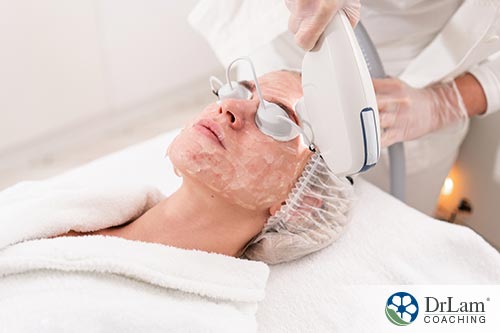 Although skin aging can be worsened by sun exposure and UV light, laser light can be used to help reduce aging in skin. Low-level laser therapy can help your skin rejuvenate by increasing its collagen production and slowing down its collagen degradation. It does this by increasing the effects of platelet-driven growth factor and by increasing the production of fibroblasts. Green laser seems to be especially useful for increasing fibroblast production.
Although skin aging can be worsened by sun exposure and UV light, laser light can be used to help reduce aging in skin. Low-level laser therapy can help your skin rejuvenate by increasing its collagen production and slowing down its collagen degradation. It does this by increasing the effects of platelet-driven growth factor and by increasing the production of fibroblasts. Green laser seems to be especially useful for increasing fibroblast production.
P. acnes, one of the primary bacteria linked to acne, creates and stores a lot of porphyrins, which are molecules that have a structure that can hold iron. When these molecules are exposed to blue light, they become excited, which leads to the formation of free radicals. These free radicals cause the damage we see in acne. When using laser therapy, red and blue light can have a synergistic effect in acne treatment.
Vitiligo is a condition where your skin and hair lose their pigmentation. It’s a form of hypopigmentation. Low-level laser therapy can help increase pigmentation in the areas that were depigmented. It does this by stimulating the proliferation of melanocytes. Melanocytes are the cells that create melanin, which is what gives your skin its color. Laser therapy can also help inhibit the autoimmunity that causes depigmentation in the first place.
Hyperpigmentation is a condition where the pigmentation in areas of your skin increases, making those areas darker. Several things can cause hyperpigmentation, like the hormonal changes that happen during pregnancy, for example. What’s interesting is that laser therapy can help hyperpigmentation as well as vitiligo. You can depigment the skin by using red and blue lasers combined, as they decrease melanin levels.
Laser therapy can also help with inflammatory skin conditions, as well as with skin burns, scars, keloids, psoriasis, and herpes sores.
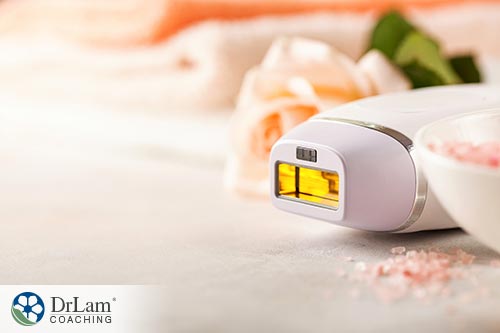 The skin’s sensitivity to UV light can vary from person to person. What you eat and the medications you take can have a significant effect on your sensitivity to lasers.
The skin’s sensitivity to UV light can vary from person to person. What you eat and the medications you take can have a significant effect on your sensitivity to lasers.
Certain foods, lotions, essential oils, and medications act as photosensitizers, making your cells more sensitive to light when they absorb these substances. If these foods are ingested orally and you are doing intravenous laser therapy, this enhances the lasers' ability to become activated at the cellular level and improves the outcome of laser therapy.
However, during topical laser therapy, the photosensitizers can cause your skin to change colors temporarily if in excess, for example. Even handling these substances can make the skin on your hands sensitive. One way to know if this has happened is if your skin gets red after laser therapy.
So if you intend on doing laser therapy topically, you should avoid these substances. Here’s a list of some common photosensitizers:
Medications that can cause photosensitivity include:
For a complete list of photosensitizing medications, read this FDA downloadable file.
Below is a list of different reviews on laser therapy's effectiveness for different conditions. Each summarized review contains a link to the original article for further details.
The Bone and Joint Task Force, an initiative by the United Nations and the World Health Organization, released a review in 2008 about neck pain. In it, they stated that a number of non-invasive treatments appeared to have some benefits. These include manual therapy, exercises, acupuncture, and low-level laser therapy.
To read more, click here.
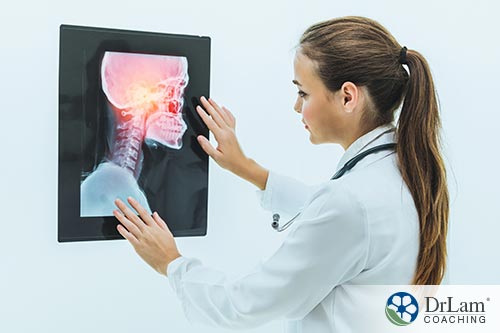 The Lancet is one of the oldest, best-known, and most prestigious peer-reviewed medical journals in the world. In 2009, they released a review of 16 randomized controlled trials with a total of 820 patients with neck pain. The review showed that low-level laser therapy reduces acute neck pain immediately after treatment. In patients with chronic pain, the therapy reduced their pain for up to 22 weeks after they completed the therapy.
The Lancet is one of the oldest, best-known, and most prestigious peer-reviewed medical journals in the world. In 2009, they released a review of 16 randomized controlled trials with a total of 820 patients with neck pain. The review showed that low-level laser therapy reduces acute neck pain immediately after treatment. In patients with chronic pain, the therapy reduced their pain for up to 22 weeks after they completed the therapy.
To read more, click here.
In APTA’s 2010 clinical guidelines, they recommended that clinicians should consider using low-level laser therapy to help with the pain and stiffness of Achilles Tendinopathy. They stated that this recommendation was based on moderate evidence.
To read more, click here.
The British Journal of Sports Medicine published a systematic review of the effectiveness of different conservative and surgical interventions for frozen shoulder. Frozen shoulder, also known as adhesive capsulitis, is a condition that makes your shoulder joint stiff and painful. In their review, they stated that they found strong evidence for the effectiveness of laser therapy in the short-term.
To read more, click here.
The International Association for the Study of Pain released a statement on myofascial pain as part of their Global Year Against Musculoskeletal Pain. Myofascial pain is pain in the muscles and/or fascia, the connective tissue that surrounds muscles. In this statement, they included laser therapy as one of the interventions with strong evidence for relieving this pain.
To read more, click here.
Tennis elbow is a condition that comes from overusing the muscles and tendons in your forearms, especially in repetitive motions. This leads to damage and inflammation, which in turn creates pain in your elbow. The BMJ conducted a systematic review of different therapies for tennis elbow, including low-level laser therapy. They concluded that laser therapy is likely beneficial for pain relief and improvement in function, short-term.
To read more, click here.
Oral mucositis is the inflammation and formation of ulcers in the mouth. It’s a common complication of cancer therapy, especially chemotherapy. It can be quite debilitating. The European Society for Medical Oncology published a systematic review with a meta-analysis of the effects of laser therapy in oral mucositis induced by cancer therapy. They concluded that red and infrared low-level laser therapy can help in the prevention of oral mucositis and also reduce the pain, duration, and severity of its symptoms.
To read more, click here.
The MASCC conducted a systematic review on the management of oral mucositis in cancer patients using laser therapy and other types of light therapy. They concluded that there is encouraging evidence that suggests low-level laser therapy could be a possible therapy for oral mucositis. They also stated that additional research is needed to evaluate its effectiveness in different cancer settings, but that the evidence was enough to allow the development of new MASCC guidelines that support its use.
To read more, click here.
Two years later, in 2014, the MASCC updated its guidelines to include laser therapy as a recommendation for the prevention of oral mucositis in chemotherapy patients, and as a suggestion for its prevention in radiotherapy patients with head and neck cancer. Recommendations are based on strong evidence while suggestions are based on weaker evidence.
To read more, click here.
More reviews and studies on the effectiveness of laser therapy on oral mucositis were conducted in the years following, including:
The Journal of Applied Oral Sciences conducted a systematic review of the effects of low-level laser therapy on the pain levels of patients with TMD. They found that when the laser is properly applied, it could reduce pain. They also state that these results could be due to laser therapy’s dose-specific anti-inflammatory, analgesic, and healing effects on the temporomandibular joint and on the painful area of the masticatory muscle.
To read more, click here.
The BMJ conducted a meta-analysis of randomized controlled trials composed of 15 studies that involved a total of 1039 participants with lower back pain. They found “moderate quality of evidence” and “clinically important benefit” for the use of laser therapy for low back pain in the short-term.
To read more, click here.
In their guidelines, the American College of Physicians included a strong recommendation for the use of laser therapy as a non-invasive intervention for acute, subacute, and chronic low back pain.
To read more, click here.
The Oral Oncology journal conducted a randomized phase III trial (from 2007 to 2015) of 94 patients with different head and neck cancers. The patients were given conventional radiotherapy as well as cisplatin every 3 weeks and also received low-level laser therapy. The findings showed the patients receiving laser therapy had a statistically significant improved response to therapy than the placebo group. This suggests laser therapy may improve the survival of head and neck cancer patients undergoing chemotherapy.
To read more, click here.
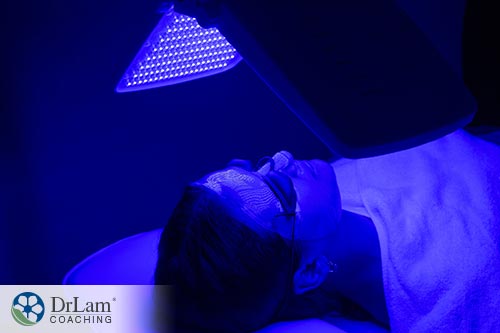 Low-level laser therapy is a safe and effective way to address many different conditions. It’s especially useful for reducing inflammation and pain, as well as rejuvenating the skin. Its an integral part of the regenerative and anti-aging medicine toolbox. Proper use is key for its effectiveness. Although it’s not yet the most popular modality for these issues, it is making its way into the mainstream. Many studies have already been conducted on its effectiveness, especially for things like oral mucositis and joint pain. However, many more studies still need to be conducted to ensure it really is as good as some believe it to be.
Low-level laser therapy is a safe and effective way to address many different conditions. It’s especially useful for reducing inflammation and pain, as well as rejuvenating the skin. Its an integral part of the regenerative and anti-aging medicine toolbox. Proper use is key for its effectiveness. Although it’s not yet the most popular modality for these issues, it is making its way into the mainstream. Many studies have already been conducted on its effectiveness, especially for things like oral mucositis and joint pain. However, many more studies still need to be conducted to ensure it really is as good as some believe it to be.
Whatever the case, the fact that it has almost no side-effects when properly used makes it tempting to try. This is also why there are many brands of home-use laser devices on the market.
But, from our experience, as well as understanding the debilitating nature of conditions like AFS and NEM dysregulation, we wouldn’t recommend all our clients try it. We believe it can be useful in some cases, ineffective but harmless in others, and harmful in others. With this form of therapy, as with any, we truly believe that it should be individualized. Your health professional should take into account your medical history, your mental/emotional state, your age, your gender, and your lifestyle when devising a treatment plan.
With AFS and NEM dysregulation, a layering process of recovery works the best. Lifestyle, nutrition, exercise, and diet all play an essential role. Additions, such as laser therapy, are part of the toolbox that can propel recovery forward and reduce recovery time, but they are not for everyone.
If you’re unsure if laser therapy, or any other type of therapy, could help you with adrenal fatigue, you can consult with the Dr. Lam Coaching team. We offer a free** no-obligation phone consultation at +1-626-571-1234 where we will privately discuss your symptoms and what your options are. You can also send us a question through our Ask The Doctor system.
© Copyright 2020 Michael Lam, M.D. All Rights Reserved.
Low-level laser therapy has become quite popular for dermatological conditions including, acne, acne scars, vitiligo, burns, and hyperpigmentation. It’s also been shown to help with frozen shoulder, tennis elbow, and lower back pain. For those with adrenal fatigue, it could help, but some caution is necessary.
